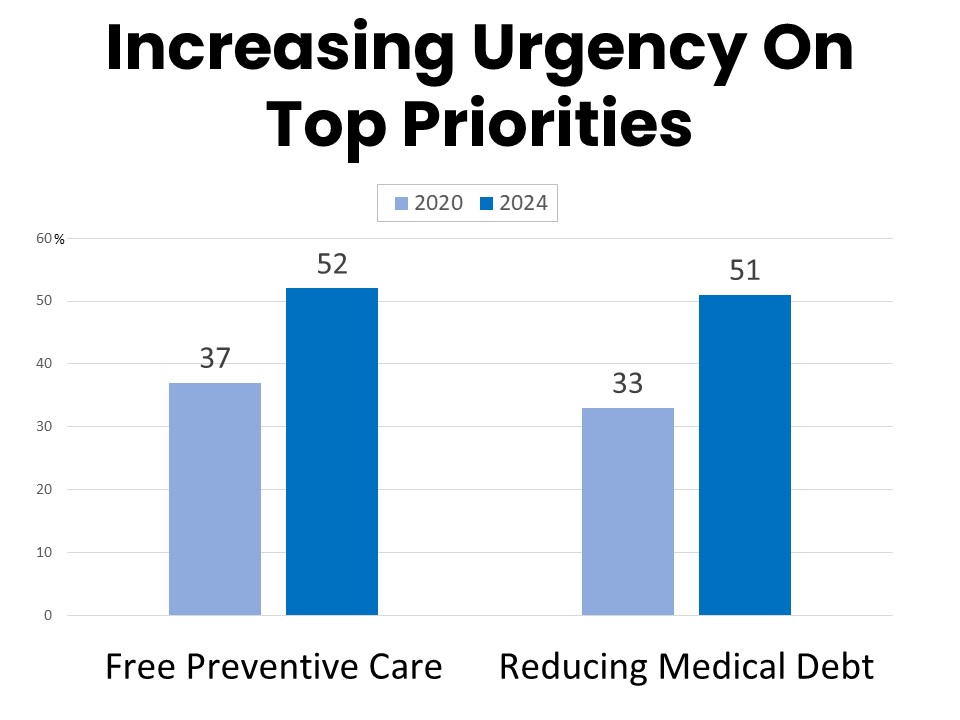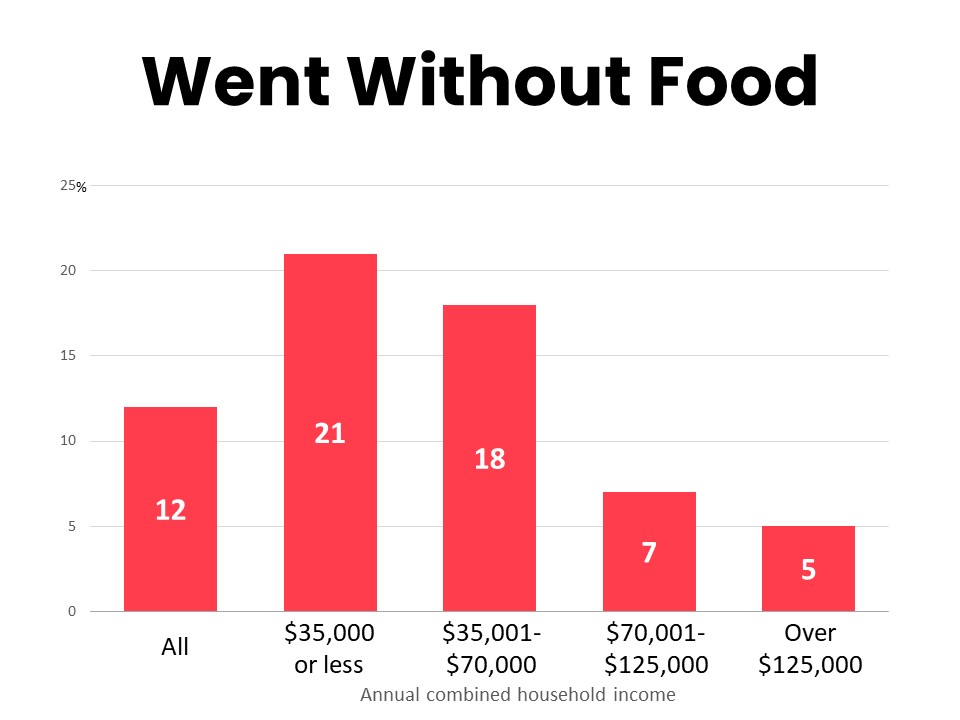Medicaid Funding Caps are a Barrier to Care for Cancer Patients & Survivors
ACS CAN opposes per capita caps, block grants, and other capped funding structures for the Medicaid program, as they endanger access to care.
The American Cancer Society Cancer Action Network (ACS CAN) empowers advocates across the country to make their voices heard and influence evidence-based public policy change, as well as legislative and regulatory solutions that will reduce the cancer burden. As part of this effort, ACS CAN deploys surveys to better understand cancer patient and survivor experiences and perspectives, through our Survivor Views research panel. The panel is a group of cancer patients and survivors who respond to regular surveys and provide important insights to support ACS CAN’s advocacy work at all levels of government.
Fielded January 3-22, 2024, our latest survey considers key priorities facing cancer patients and survivors and explores food insecurity. The web-based survey was conducted among 1,524n cancer patients and survivors nationwide who have been diagnosed with or treated for cancer in the last seven years.
Ensuring that all cancer screenings and preventive services are free for patients remains the top priority for respondents, consistent with data collected in 2020. From a list of twelve potential issues, 52% of cancer patients and survivors surveyed chose safeguarding free cancer screenings and preventive care as the most important way to help people with cancer. While this has consistently been the top priority, the importance of this issue has increased from 37% in May 2020 to 52% today, possibly reflecting concerns related to the Braidwood Management Inc. v. Becerra case which could challenge the ACA requirement that most private insurance plans cover recommended preventive care services without cost sharing.

Finding ways to help cancer patients stay out of medical debt and reduce the negative impacts of medical debt they have already accumulated is also a top priority for cancer patients and survivors. The importance of addressing medical debt has increased from 33% in 2020 to 51% today. Notably, this issue is seen as equally important across all income groups, underscoring the broad impact of medical debt. While many other concerns remain important to cancer patients and survivors, sentiment has galvanized around these two issues as the top priorities by a wider margin than in the past.
Third on the list of priorities is ensuring coverage for genomic diagnostic testing so that cancer patients have access to the most innovative and effective treatments. Thirty-eight percent of respondents consider this issue to be in their top three priorities, up from 30% in 2020. All other issues tested were selected by fewer than one-quarter of respondents.
Forty-one percent of cancer patients and survivors say the cost of their cancer care has at some point affected their ability to afford food. Those most likely to have experienced this include respondents with annual household income under $35,000 (70%), patients and survivors who are Hispanic/Latino (65%) or Black/African American (60%), Medicaid enrollees (58%), those with lower educational attainment (51% of those with less than a four-year college degree), LGBTQ+ respondents (46%), and residents of US territories (70%). Residents in states that have not yet expanded Medicaid (44%) are also more likely than those in expansion states (37%) to have felt their ability to purchase food impacted.
Similarly, 41% have at some point worried about their household running out of food due to the costs of their cancer care. An even greater number have made trade-offs in the quality of food they purchased while paying for their cancer care; in an effort to cut costs to afford their care, 47% have worried that the food they had to eat was not good for their health or well-being. The costs of cancer care have caused 40% to accumulate debt in order to afford food, such as buying groceries on credit cards they were unable to pay off while paying cancer costs.

Nearly one-third (32%) have at some point felt they had to choose between buying enough food and paying for cancer care or treatment. Eleven percent ultimately skipped or delayed recommended care in order to ensure their household could afford food, while another 12% considered it but were able to maintain their care. Twelve percent went without adequate food for a period of time due to the costs of their cancer care, including one-in-five of the lowest income group. Some who worried about affording adequate food while paying for their cancer care found help; 17% of respondents received assistance from a food bank or other resource, and 12% participated in a program such as SNAP, NAP, or WIC.

Respondents in lower income segments are more likely to be impacted by food insecurity while juggling the costs of cancer care, however even the highest income groups are impacted. One-out-of-six in the highest earning households (over $125,000 annual income) report the costs of their cancer care impacting their ability to afford food, along with 29% of those in the $70,000-$125,000 range. While 21% of those with annual household income under $35,000 went without adequate food at some point, 5% of those with household income over $125,000 per year went without adequate food for a time while paying for their cancer care.

ACS CAN’s Survivor Views research initiative was designed to support the organization’s efforts to end suffering and death from cancer through public policy advocacy. Data provided by cancer patients and survivors as part of this project allows for a greater understanding of their experiences and opinions on cancer-related issues and gives voice to cancer patients and survivors in the shaping and advocating of public policies that help prevent, detect, and treat cancer and promote a more positive quality of life for those impacted.
To ensure the protection of all participants in this initiative all research protocols, questionnaires, and communications are reviewed by the Morehouse School of Medicine Institutional Review Board.
The survey population is comprised of individuals who meet the following criteria:
Potential Survivor Views participants were invited to participate through email invitations, social media promotion, and partner group outreach. Those who agreed to participate after reviewing the informed consent information completed a brief survey including demographic and cancer history information to inform analysis as well as topical questions as discussed in this document. The data were collected between January 3-22, 2024. A total of 1,542 cohort participants responded to the survey. Differences reported between groups are tested for statistical significance at a 95% confidence interval.
The American Cancer Society Cancer Action Network (ACS CAN) advocates for evidence-based public policies to reduce the cancer burden for everyone. We engage our volunteers across the country to make their voices heard by policymakers at every level of government. We believe everyone should have a fair and just opportunity to prevent, detect, treat, and survive cancer. Since 2001, as the American Cancer Society’s nonprofit, nonpartisan advocacy affiliate, ACS CAN has successfully advocated for billions of dollars in cancer research funding, expanded access to quality affordable health care, and advanced proven tobacco control measures. We stand with our volunteers, working to make cancer a top priority for policymakers in cities, states and our nation’s capital. Join the fight by visiting www.fightcancer.org.